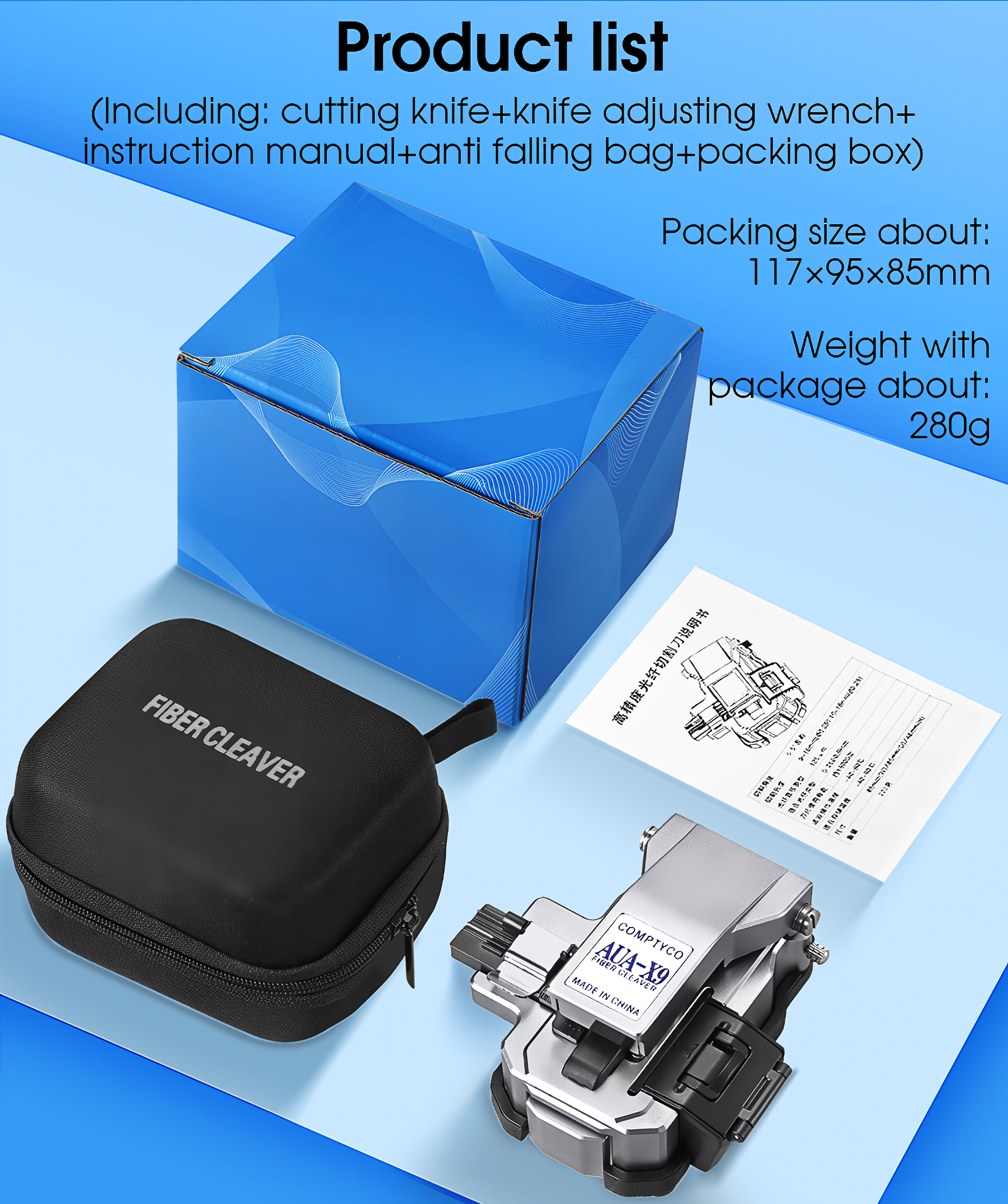How to Properly Use a Fiber Cleaver for Perfect Cuts Every Time
Introduction to Fiber Optic Preparation
Fiber optic technology is at the heart of today’s communication infrastructure. With its ability to transmit massive amounts of data at lightning speed, fiber optic cabling has become indispensable for telecommunications, data centers, and even residential internet services. However, to achieve reliable connections and low-loss splicing, the preparation of the fiber is crucial. A key tool in this preparation is the Fiber Cleaver. This precision device ensures that the fiber end face is cut cleanly and at the correct angle, both of which are vital for reducing signal loss and achieving long-term stability in splices or connectors. Using a Fiber Cleaver properly is not only a matter of convenience but a necessity for high-performance networks.
Understanding the Fiber Cleaver
What Is a Fiber Cleaver?
A Fiber Cleaver is a specialized tool used to precisely cut or “cleave” optical fibers. Unlike cutting metal wires or copper cables, fiber optic strands are delicate and require extreme accuracy. The Fiber Cleaver does not simply slice the fiber; instead, it scores the glass at a precise angle and then applies controlled pressure to produce a clean break. This method creates a smooth end face that is perpendicular to the fiber’s axis, which is critical for efficient splicing and minimal optical loss.
Why Cleaving Is Important
When fibers are joined using fusion splicing or mechanical connectors, the quality of the cleave determines how well the cores align. A poor cut can cause high insertion loss, back reflection, or even physical damage to the splicing equipment. A properly used Fiber Cleaver guarantees the uniformity needed for consistent, reliable connections across an entire network.
Preparing to Use a Fiber Cleaver
Safety Considerations
Before using a Fiber Cleaver, it is important to observe safety protocols. Optical fibers are made of glass, and tiny fragments from the cleaving process can be hazardous if not handled properly. Always wear safety glasses, use a disposal container for fiber scraps, and never touch the fiber ends with bare hands.
Cleaning and Stripping the Fiber
Proper preparation starts with stripping the protective coating from the fiber. The stripped fiber must then be cleaned with lint-free wipes and isopropyl alcohol to remove any debris or residue. Cleanliness is crucial because dirt or contamination on the fiber can cause poor cleaves and lead to high optical loss.
Setting Up the Fiber Cleaver
Different models of Fiber Cleaver exist, ranging from handheld portable devices to high-precision bench-top models. In all cases, the cleaver must be calibrated and clean. The cutting blade should be inspected regularly and rotated or replaced as needed to ensure consistent performance.

Step-by-Step Guide to Proper Cleaving
Step 1: Insert the Fiber
Once stripped and cleaned, the fiber is carefully inserted into the Fiber Cleaver’s clamp. The fiber must be placed so that the correct length of bare glass extends beyond the clamp for scoring. Most cleavers have a guide or scale to help position the fiber correctly.
Step 2: Secure the Fiber
The fiber is then clamped into position to prevent movement. Proper clamping ensures that the fiber remains stable during the scoring and breaking process, which is essential for achieving a clean, perpendicular cut.
Step 3: Score the Fiber
The Fiber Cleaver uses a diamond or carbide blade to lightly score the fiber. This scoring process creates a microscopic flaw that controls how the glass will break. Unlike cutting, the goal is not to sever the fiber with the blade but to guide the break at the desired angle.
Step 4: Apply Tension
Once scored, controlled tension is applied to the fiber, causing it to break cleanly along the score line. High-quality Fiber Cleavers apply this tension automatically, ensuring consistent results. The result is a smooth, flat end face that is ideal for splicing.
Step 5: Inspect the Cleave
Inspection is critical after cleaving. Using a fiber inspection microscope, the technician checks the quality of the end face. A perfect cleave will appear smooth and flat, with no chips, cracks, or angle deviations. Imperfect cleaves must be redone, as they can compromise splice quality.
Best Practices for Using a Fiber Cleaver
Keep the Blade Clean and Sharp
Dust, oil, or wear on the blade can cause inconsistent cleaves. Regular maintenance, including cleaning and rotating the blade, is essential for prolonging its life and maintaining accuracy.
Handle Fibers Carefully
Fibers are delicate, and even minor mishandling can cause micro-cracks or contamination. Always use proper tools and avoid bending the fiber excessively during preparation.
Maintain Consistency
Consistency is key in large-scale projects. Following the same procedures and using a calibrated Fiber Cleaver ensures that every cleave is uniform, reducing variability in splice quality.
Use Proper Lighting and Magnification
Working with optical fibers requires precision. Adequate lighting and magnification help technicians position fibers correctly and inspect cleaves effectively.
Common Mistakes to Avoid
Poor Fiber Preparation
Failing to clean and strip the fiber properly is one of the most common causes of bad cleaves. Residue or improper stripping can cause angled cuts or chipped end faces.
Incorrect Fiber Positioning
If the fiber is not positioned correctly within the cleaver, the resulting cleave may be angled, leading to high splice loss. Always use the cleaver’s alignment guides.
Overlooking Blade Maintenance
Using a worn or dirty blade can compromise cleave quality. Neglecting maintenance can also damage fibers and reduce the cleaver’s lifespan.
Ignoring Safety Protocols
Not properly disposing of fiber shards can lead to health hazards. Always collect scraps in a dedicated container and handle them responsibly.
Applications of a Fiber Cleaver
Fusion Splicing
Fusion splicing is the most common application of cleaved fibers. A high-quality cleave ensures that the fiber cores align precisely, allowing the splicer to fuse them together with minimal loss.
Mechanical Splicing
In mechanical splicing, fibers are aligned in a connector or sleeve. Clean, flat cleaves are essential for proper alignment and low insertion loss.
Connectorization
When installing connectors on fiber ends, the quality of the cleave directly impacts the performance of the connector. A poor cleave can cause reflections and signal degradation.
Testing and Research
In laboratory environments, Fiber Cleavers are used to prepare samples for optical testing, ensuring reliable experimental results.
The Future of Fiber Cleaving Technology
As fiber networks expand with the growth of 5G, data centers, and global connectivity, demand for faster and more reliable fiber preparation tools is increasing. Modern Fiber Cleavers are becoming more automated, incorporating features like automatic blade adjustment, improved precision mechanisms, and integration with splicing machines. These innovations reduce technician error and improve efficiency in large-scale deployments.
Conclusion
Using a Fiber Cleaver properly is a fundamental skill in fiber optic installation and maintenance. The cleaving process directly affects splice quality, insertion loss, and overall network performance. By understanding how the tool works, preparing fibers carefully, following step-by-step procedures, and avoiding common mistakes, technicians can achieve perfect cuts every time. As fiber optic networks continue to expand worldwide, mastering the use of a Fiber Cleaver will remain an essential skill for ensuring high-performance and reliable communication systems.
FAQ
What is a Fiber Cleaver used for?
It is used to make precise, clean cuts on optical fibers to prepare them for splicing or connectorization.
Why is cleaving important in fiber optics?
Because the quality of the cleave determines the efficiency of splicing and the amount of signal loss.
Can I use a regular cutter instead of a Fiber Cleaver?
No, regular cutters cannot provide the precision required. A Fiber Cleaver ensures smooth, perpendicular cuts critical for optical performance.
How often should the cleaver blade be replaced?
It depends on usage, but blades can usually be rotated several times before replacement. Inspect regularly for wear.
What happens if a cleave is not perfect?
Poor cleaves cause higher splice losses, back reflections, or even failure in the splicing process.
Are Fiber Cleavers difficult to use?
They require care and practice, but with proper training, they are straightforward to operate.
Can Fiber Cleavers cut all types of fibers?
Yes, they are designed to work with both single-mode and multi-mode fibers, though some models are optimized for specific applications.
How should fiber shards be disposed of?
They should be placed in a dedicated fiber disposal container to avoid injury or contamination.
Do Fiber Cleavers require calibration?
Yes, regular calibration and blade maintenance are necessary for consistent performance.
Are automated Fiber Cleavers worth the investment?
For large-scale projects, automated cleavers save time and reduce errors, making them highly beneficial.
Table of Contents
- Introduction to Fiber Optic Preparation
- Understanding the Fiber Cleaver
- Preparing to Use a Fiber Cleaver
- Step-by-Step Guide to Proper Cleaving
- Best Practices for Using a Fiber Cleaver
- Common Mistakes to Avoid
- Applications of a Fiber Cleaver
- The Future of Fiber Cleaving Technology
- Conclusion
-
FAQ
- What is a Fiber Cleaver used for?
- Why is cleaving important in fiber optics?
- Can I use a regular cutter instead of a Fiber Cleaver?
- How often should the cleaver blade be replaced?
- What happens if a cleave is not perfect?
- Are Fiber Cleavers difficult to use?
- Can Fiber Cleavers cut all types of fibers?
- How should fiber shards be disposed of?
- Do Fiber Cleavers require calibration?
- Are automated Fiber Cleavers worth the investment?







